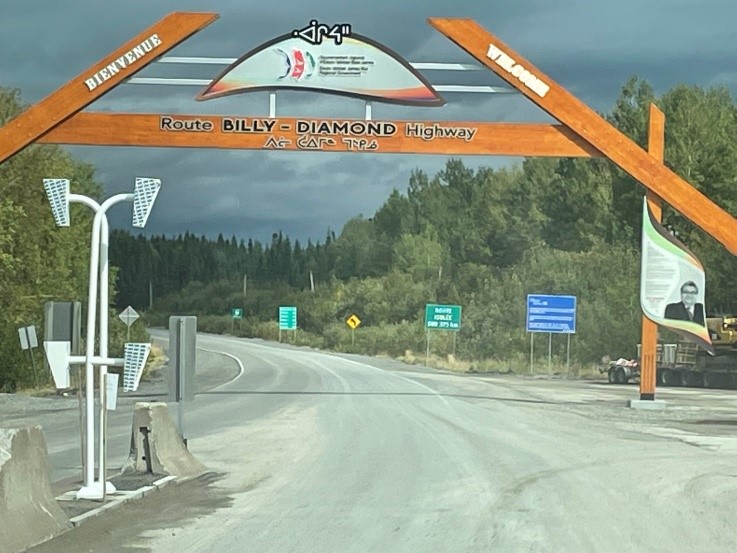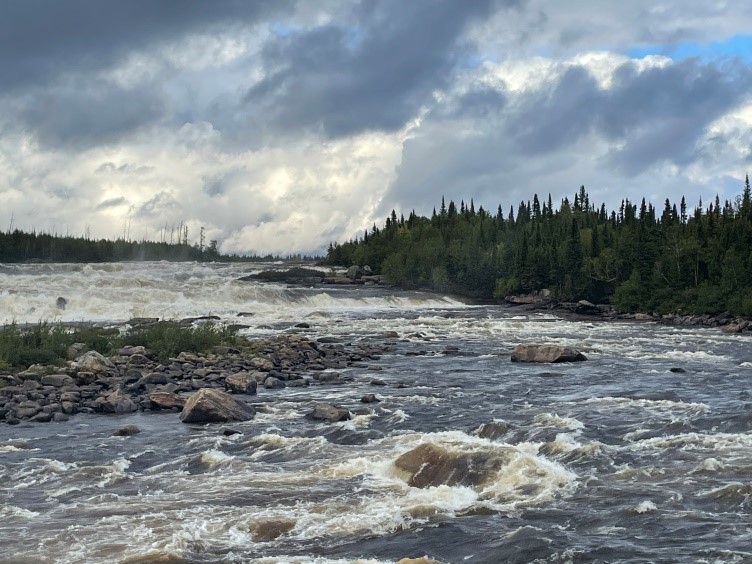Update Two: Writing with the James Bay Cree: Ruth DyckFehderau
Dr. Ruth DyckFehderau - 3 June 2022
For several years now, in addition to teaching occasionally in EFS, I’ve been writing nonfiction stories with the James Bay Cree of Northern Quebec. I’m currently writing up residential school recovery stories (my Cree supervisors hire outsiders for trauma stories partly because “our own writers have enough to carry”) and in March ’23 we are launching the first book in the series.
Last year, I posted a description of the work here. This time, I’ll tell you a couple of stories from a recent trip North. Incidentally, this posting has been approved by my supervisors at Cree Board of Health and Social Services of James Bay (who own copyright on the books).

I usually fly North twice a year, for two months each time, and try to visit about three (of nine) Cree communities. This past fall, my partner Dave came with me. Because we were going only to road-accessible communities, we rented a truck and drove up the Billy Diamond Highway, formerly the James Bay Highway, originally constructed to take huge machines further North to build hydroelectric dams. (Billy Diamond, after whom the highway is named, was an interesting figure. More here).

The drive itself is beautiful.
Our first stop was a community on the coast of James Bay. As often happens, a storyteller invited us to her camp, about 130 kilometres inland, because she wanted to tell her story "at home on the land." All afternoon she talked and I took notes while a pot of moose stew simmered on the hotplate. Afterwards, we joined her family at the long table, we all ate moose stew, and then Dave and I set out for the drive back to the community and our lodging.
The sun was sliding into the trees, dusk was pressing down, and wildlife was out. In evenings previous, we had seen bobcats and bears, moose and foxes, muskrat and beaver and grouse, so Dave drove carefully. At one point, the bushes rustled, Dave slowed the truck – and a wolverine ran out of the bushes and charged the truck!
My first response was Wow! What a gorgeous, angry animal!
My second response was Wow! Never thought I would see a wolverine!!
And my third response was to chuckle that an animal that size would threaten a truck. We drove back the rest of the way without incident.
The next day, at the place I used an office, I told the ladies at coffee break that we had seen a wolverine and I felt lucky.
Like in a cartoon, they all set down their mugs and looked at me with the white-people-are-crazy look. Their colour drained.
"You gotta tell Reggie,' they said. (Not his real name.)
Then the stories started coming out. Wolverines trashing camps. Wolverines taking down moose. Wolverines killing a family of bears. Wolverines going into camps and carrying away the guns.
“Ohhkay,” I said, suddenly more sober. “But wolverine vs truck?”
“Just a tire,” they said. “If the truck is going slowly enough, one claw would do it. Then it’d just sit and wait. Eventually someone has to change the tire. You gotta tell Reggie.”
Reggie was the head of Public Safety. We met in the dining room of the beautiful lodge and looked out over the wide river.

"Maybe you saw a small bear," he said.
"No Reggie. I've seen hundreds of bears. They don't have long, lush tails."
"Foxes do! Maybe you saw a fox."
"No Reggie. Foxes have pointy ears and small delicate faces and slim bodies. This animal had round ears, an astonishingly angry face, and much thicker legs with feet turned inwards."
"Porcupine. Was it a porcupine?"
"No Reggie. Porcupines waddle and shift their weight from side to side. This animal was muscled and fast. No waddle. Kind of a rounded back."
And on it went.
Finally I pulled out my phone, showed him a wolverine pic, and said "This is what we saw, Reggie. It was beautiful."
His face. He became so sad. "You saw a wolverine,” he said. “I gotta get on the radio.”
He reached for his phone and looked at me: “So, Ruth. At what kilometre did you see the wolverine?"
And now my face fell: the access road from the camp back to the community was a straight gravel road, over 100 kilometres long, with trees on both sides the entire way. The only distinguishing features I had noticed were occasional kilometre markers.
"Oh Reggie,” I said. “I'm a white girl. I didn't know it was important to notice that, so I didn't."
He smiled, knowingly, ever so patiently. “It’s okay,” he said. “We can do this. Tell me about the light."
And then I realized it couldn't have been in the first 30 kilometres of the drive because there had still been orange in the sky. And it couldn't have been in the last 30 kilometres because by then the moon was bright.
Then he said, "Did the animal come out of trees or grasses or bushes?"
"Bushes, definitely. The trees started about ten feet back from the bushes."
And on it went.
In a few minutes, Reggie had it down to a 20 km radius, which is about the amount of land a wolverine would cover in a day. And then he went on the radio.
The next day, as Dave and I left the community, we noticed that everyone – guy stopping at the roadside to pee, folks going out for a walk, kids on ATVs – all carried rifles with them.

After completing my work at the coastal community, we crossed Northern Quebec to reach the inland communities. For this, we took the 400-kilometre Route du Nord, a remote dirt logging road. Except for the area surrounding a single community about 100 kilometres in, the road has no cell service whatsoever.
Again, Dave was the one driving and all was well for about 30 kilometres. And then a storm hit. In recent years, storms have been particularly intense. In the next thirty minutes, as much water fell as I had ever seen in a half hour of a tropical storm (while living in places where one expects tropical storms). The road crumbled away before us like cookie dough. We slowed right down.

Another 30 kilometres, and a sharp rock, churned up by rain, punctured a tire. That's when we realized that the rental place, where we had paid extra for a gravel-ready truck, with 8-ply tires and a proper spare, had in fact sent us on our way with mere 5-ply tires and a wee donut-tire spare. And I hadn’t bothered to check.
Ahead 40 kilometres was a Cree community that we knew. In the astonishing downpour, Dave changed the tire. Then, in the truck, he changed his clothes. Then, we puttered forward on the donut tire until we reached the community. Finally the rain was letting up.
At the community entrance sat the Covid blockade where we were meant to show vaccination papers. We asked the guy at the blockade to call ahead to the garage because we needed either to buy a new tire or plug the old one.
“No point,” he said. “The garage is closed. The garage guy is away.”
So we drove to the gas station. Maybe it would have a tire kit.
The gas station had closed early that day.
Thinking that we were probably spending the night in that community, we drove to the grocery store to get a few things for dinner.
In towns so small, everyone notices the strangers. A few seconds after we pulled into the grocery parking lot, we were surrounded by people staring at the donut tire and then at us and then back at the donut tire.
And then someone said that the gas station had just closed for supper and would re-open in thirty minutes.
And then someone else ran into the store to get the uncle of the guy who owned the garage. He was buying groceries. The garage, it turned out, once belonged to him.
“Let me drop off the groceries,” he said. “My wife needs them for dinner. I’ll meet you at the garage in fifteen minutes.”
Another half hour, and he had plugged our original tire, given us a few more tire plugs in case we had further problems (we didn't - the storm and the worst part of the road was behind us), and sent us on our way.
We arrived at our destination at midnight. The tire fiasco added about four hours to our journey. Ah, life in the North.
(Somewhere in all of that, I did my work, a little wiser than I had been before.)